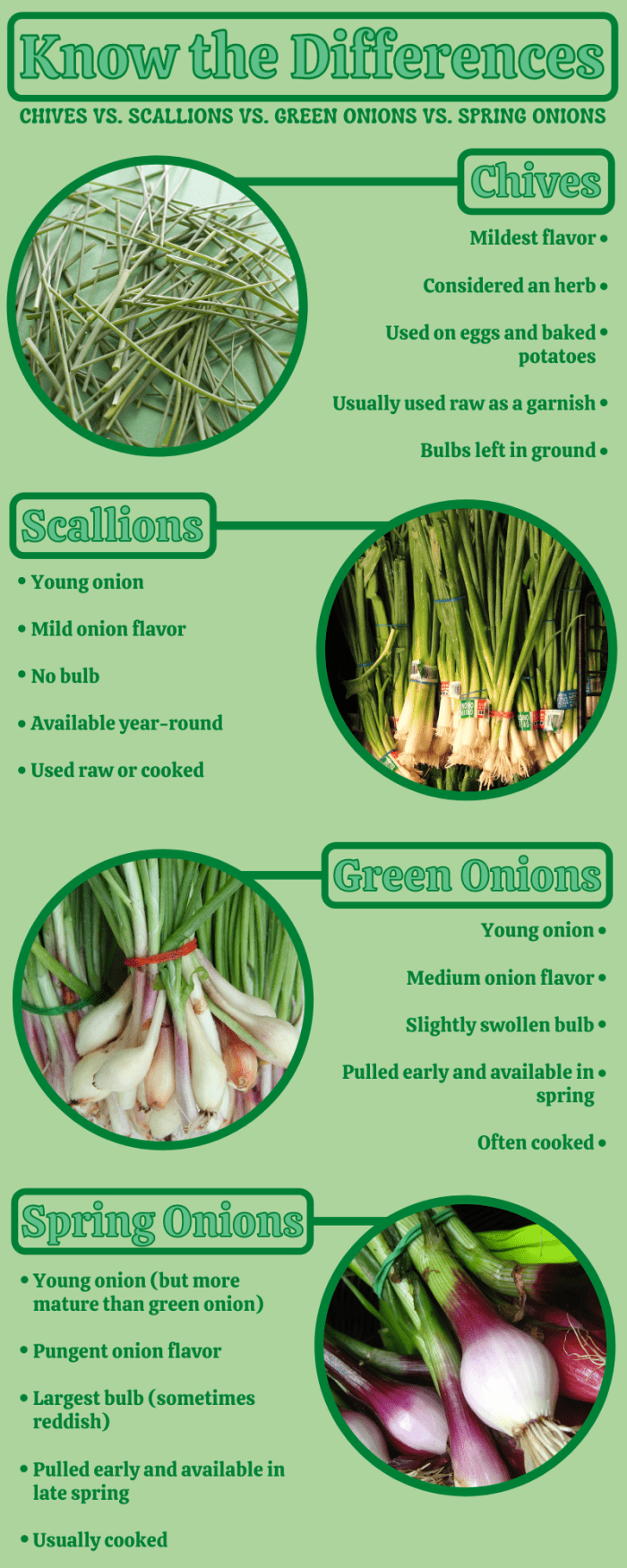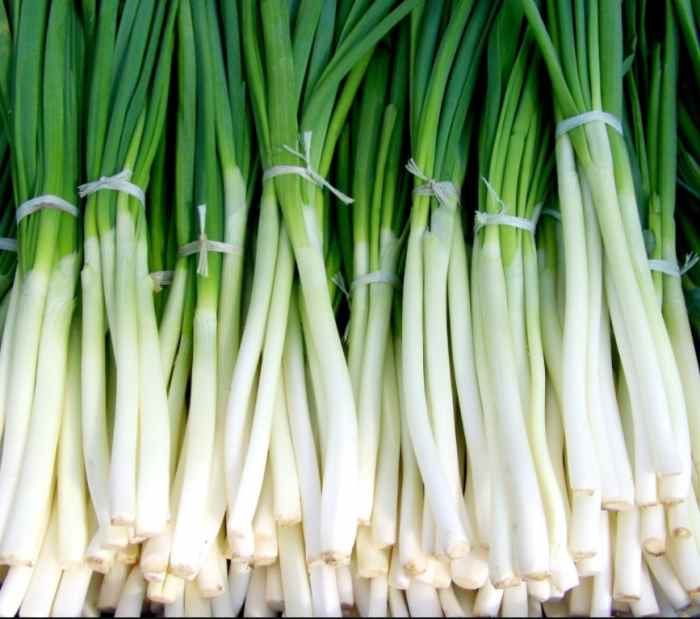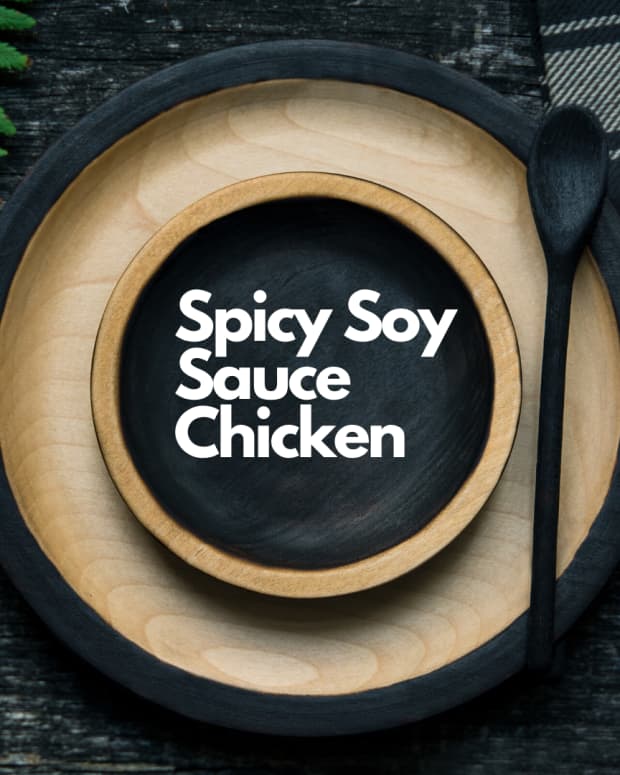Are Scallions the Same as Green Onions? (+Bonus Recipe!)
Linda explores food facts, folklore, and fabulous recipes, one ingredient at a time.
Vidalia is sweet on onions, Gilroy loves garlic, and the leek is chic in vichyssoise. But, in the empire of alliums, the green onion receives no fanfare or festivals. We can’t even agree on the name.
Scallions and Green Onions Can Be Confusing
Scallions, green onions, and spring onions—they look similar, taste similar (though some have more of a bite than others), and they can be used interchangeably, but they are not all the same plant.
Even some of the experts on well-known cooking websites get it wrong, promoting the idea that green onions and scallions are one and the same. Let's find out how green onions and scallions differ from each other—and where spring onions fit into the mix.
What Are Scallions?
A true scallion is a distinct cultivar in the onion family; unlike its allium cousins, it does not produce a prominent bulb. The white portion below ground remains slender, mirroring the girth of the above-the-soil greens. All but the roots of the scallion can be used raw; the white and green parts are equally tender with a mild onion flavor.
In the world of onions, there are many shapes and sizes—the Vidalia sweet onion is a softball-sized orb, one of the largest in the family. Mid-sized red, white, and yellow onions are the ones we slice and dice for casseroles, soups, and stews. On the opposite end of the spectrum are chives; they give up their green leafy stems for the sake of garnishing baked potatoes. Their pea-sized bulbs remain in the ground to regrow year after year. A notch above chives there are scallions. We commonly refer to them as spring onions or green onions too, a misnomer, but an understandable mistake.
What Are Green Onions?
We’ve determined that scallions are a slender, non-bulbing onion. Next in line is the green onion, not a particular cultivar, but an onion that is harvested before it develops a large bulb. They are almost always served raw, but in Asian cuisine they may be grilled or tossed into fried rice. Gardeners often retrieve these onions when they are thinning their vegetable beds of young plants so that the late-season onions will have room to grow.
What Are Spring Onions?
Spring onions look very much like green onions, so it’s no wonder that there is some confusion. Spring onions have been left in the soil longer than green onions, so their bulbs have grown larger, but they are still harvested early. If they were left in the ground longer they too would become a bulbing onion.
Summary: Scallions vs. Green Onions vs. Spring Onions
| Scallions | Green Onions | Spring Onions | |
|---|---|---|---|
Size of bulb | No bulb | Slightly swollen | Large |
Season | Available year-round | Spring and Summer | May/June depending on area |
Flavor | Mild | Medium onion taste | Pungent |

From flavor profiles to suggested uses, here are a few quick differences between chives, scallions, green onions, and spring onions.
freefoodphotos, CC BY 3.0; Daderot, CC0; Jeremy Keith from Brighton & Hove, UK, CC BY 2.0
FAQs
Perhaps you still have a few questions; I have the answers here.
How do you store green onions?
The best way to store whole green onions, with the roots attached, is to wrap them in a damp paper towel and then place them in a resealable plastic container (or zip-lock bag). They should last for at least a week in the refrigerator.
Diced green onions can be kept in an airtight container in the refrigerator for about five days.
What part of green onions do you use?
All parts of the green onion (except the roots) can be used. When stored properly they will be crisp and have a pleasant, mild onion flavor.
Are green onions, scallions, and spring onions interchangeable?
Yes, you can use green onions in place of scallions, and vice versa. Spring onions can be swapped for scallions or green onions but keep in mind that they have a stronger onion flavor.
Can you substitute green onions for leeks?
Leeks are a unique part of the onion family; they’re prized for the white base portion of the plant—large, tender, and with a subtle onion-garlic flavor. Green onions are much smaller and don’t have that garlic nuance, but in a pinch, they can be a stand-in for leeks.
What about chives? Are they related to onions?
If it looks like an onion, smells like an onion, and tastes like an onion, it must be an onion, right? Well not so in the case of chives. Botanically they are a grass, an edible grass with pretty pink flowers (which are edible too). In the culinary world, they are classified as an herb.
Can you regrow scallions and green onions?
Yes, you can! It's easy to do and will pay delicious dividends. Leave about an inch or so of the white attached to the roots. You can plant this in your garden in a sunny location and it will grow again. Or, you can simply place the root end in a glass of water and set it on a sunny windowsill. Within a week you will see new greens that you can snip and use.
What’s a great recipe with scallions as the main ingredient?
Flaky, chewy, crunchy, oniony—all of those qualities describe the perfect scallion pancake. We can find this flavorful Asian side dish at street food carts and in bustling dim sum restaurants. Everyone loves them!
Scallion Pancake Recipe
Unlike Western pancakes, which are formed with a pourable batter, scallion pancakes are made from dough that is rolled into a thin disk, brushed with oil, and then rolled jelly-roll fashion. The resulting rope of dough is then shaped into a snail shell spiral and then flattened once again into a disk. This might sound like an odd way to build a pancake, but the rolling and re-rolling is what helps create the scallion pancake’s uniquely flaky and layered texture. Think about the delicate crisp layers of a croissant; that is precisely what you will find in these savory Asian flatbreads. Here’s my favorite recipe.
Ingredients
- 2 cups all-purpose flour
- 1/2 teaspoon table (not Kosher) salt
- 1 cup hot water (this is important)
- 2 scallions, green part only, thinly sliced
- 3 tablespoons toasted sesame oil
- Cooking oil for frying (a neutral oil such as canola, is best)
Instructions
- Combine the flour, salt, and hot water in a large mixing bowl. Stir to combine. (Note: The temperature of the water is critical to the success of these pancakes. Cold water will result in a stretchy, resilient, gluten-tight dough, much like the crust for a pizza. Hot water dough is much easier to work with; the glutens are relaxed and allow you to roll out the dough without resistance.)
- The dough will be loose and shaggy. You might be tempted to add more water—resist that urge. Cover the bowl and allow the dough to rest for 30 minutes. In that time the flour will hydrate (absorb the water) and be ready for the next step.
- Knead the dough until it is smooth. Divide into eight equal-sized portions.
- Roll each piece of dough into a disk about 8 inches in diameter.
- Paint each disk with some of the sesame oil. Roll up each disk into a tight cylinder. Shape the cylinder into a spiral, flatten with your hand, and then roll out again to an 8-inch disk.
- Once again, paint the disk with sesame oil, top with a portion of the scallions, roll up again, coil, flatten, and roll out to an 8-inch disk.
- Add a small amount of oil to a skillet; heat to medium and cook the pancakes, one at a time, for about 2 minutes per side.
Would you like a demonstration of how to make scallion pancakes? The staff of Serious Eats prepared a three-minute video to show just how easy it is.
Sources
© 2021 Linda Lum
Comments
Linda Lum (author) from Washington State, USA on February 12, 2021:
Eric, have you ever had a scallion pancake? This would be a fun one for you and Gabe to do in your spare time.
Eric Dierker from Spring Valley, CA. U.S.A. on February 12, 2021:
Most excellent as always. I had no clue about this. I like them all. But I reckon now I know how different they are.
Linda Lum (author) from Washington State, USA on February 11, 2021:
Pamela, that's a funny story from your past and, as it turns out, you were "almost" right. Chives are a grass, not an onion.
Pamela Oglesby from Sunny Florida on February 11, 2021:
Linda, this is a very itnresting articld. How could I get this age and not know these things.
Once when I was quite young my grandfatheer put chives into my scrambled eggs. When I woke up that day i saw him mowing the grass. I was quite convinced he put grass into my eggs. I could hardly wait until my parents picked me up that day so I could tell them about the grass. I had not thought of that memory in many years.
Your article gives us some excellent information. I appreciate all of it, as always.
Linda Lum (author) from Washington State, USA on February 11, 2021:
Thank you, Flourish. Despite the snow, my chives are popping up in the flower beds; I'm sure the garlic and onions will be right behind them. Thanks for stopping by, and my love to you and your family as well.
FlourishAnyway from USA on February 11, 2021:
What a perfect topic and something I have wondered more than a time or two. Great article! I hope you are doing well. Much love to you and yours.
Linda Lum (author) from Washington State, USA on February 11, 2021:
Dora, I'm glad you found this entertaining.
Linda Lum (author) from Washington State, USA on February 11, 2021:
John, timing is everything, and I posted this one in the afternoon (morning for you). I created this under the ECP I wrote to you about a few days ago.
Linda Lum (author) from Washington State, USA on February 11, 2021:
Sis, that sounds great!
I like "sconions." Makes perfect sense to me.
The scallion pancakes are a snack (street food) or served as one of many food items at a Dim Sum.
Linda Lum (author) from Washington State, USA on February 11, 2021:
Bill, that's just one of the many things I love about you.
Dora Weithers from The Caribbean on February 11, 2021:
Thanks for the explanations. Now I'm sure that what's in my garden are green onions; and that my grandmother made scallion pancakes though we never called them so. Quite a lesson!
John Hansen from Queensland Australia on February 11, 2021:
Linda, I finally caught your article early enough to comment..yay! Thank you for sharing the difference between scallions, green onions, and spring onions. I had no idea they were different, but I really love using them in recipes, as well as chives/garlic chives.
The recipe for the scallion pancakes looks great too. Take care
Shauna L Bowling from Central Florida on February 11, 2021:
I just bought some scallions last week for a recipe I made for meal prep. It was orzo with spinach, scallions, and feta. Delicious!
When I was younger I called scallions "sconions". They are, kinda, right?
The scallion pancakes look delicious. How are they normally served, Linda? They look like they'd be great on their own for breakfast or even as a snack.
Bill Holland from Olympia, WA on February 11, 2021:
Sheez, I'm more confused now than I was before I read this. LOL I'm just teasing you; I hope you know that. All I know is I like green onions right out of the garden, not in a recipe but just chomping down on them, with salt, of course. My God what a backwoods dork I am!!!!
Happy Snow Days, my friend. Be safe!




















